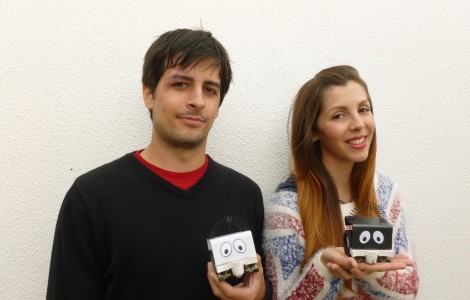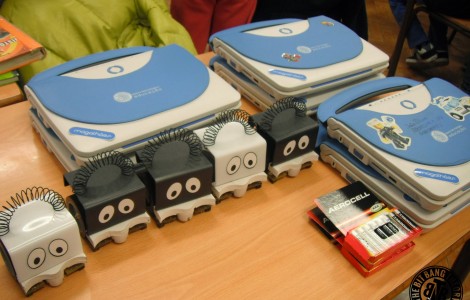 After the Magalhães, the Infantes may arrive at Portuguese schools. The invasion of small educational robots made in Algarve is still in its infancy, but there is potential to convince teachers and children for a fun way of learning that develops students' abilities in various aspects.
After the Magalhães, the Infantes may arrive at Portuguese schools. The invasion of small educational robots made in Algarve is still in its infancy, but there is potential to convince teachers and children for a fun way of learning that develops students' abilities in various aspects.
But what are the Infants? Bone Infants are small robots developed by two students from the University of Algarve, Bruna Carmo, Master in Teaching 1st and 2nd Cycle, and Mário Saleiro, PhD in Computer Engineering.
«Bruna wanted to do a master's degree using educational robotics, but when it comes to that, Lego robots are used that cost 300 euros. There are other kits but they are also expensive and there was no money to buy the robots. She spoke to me and I already had the idea of making some small robots for another application, but I still didn't have time. As I had something planned, I thought I could adapt them to make them simpler and cheaper,” he told Sul Informação Mario Saleiro.
And the goal was achieved. Each Infant it has a production cost of about 10 euros and, according to Mário Saleiro, in two minutes it is ready to be used in the classroom, using a minicomputer with a low production cost (50 euros), which works as a point of access to other computers.
«The only thing the teacher has to do is connect a USB cable for power, which can be a mobile phone charger. The computer (Raspberry Pi) starts for two minutes, which is the time that teachers can use to put the batteries in the robot, and it works. The way to control the robot is also easy, through a web browser, dragging blocks without any programming. The computer provides the wi-fi connection and can be controlled from any other computer. The explanation takes another two minutes and the children are left to play and learn for two or three hours».
But what does the Infant and what does he do? «The robot has sensors to follow l lines and detecting crosses. It is supposed to navigate on a white sheet with black lines. It detects the line, which is like a road, and follows instructions programmed by the children in a web browser. When you reach an intersection, follow these directions. The idea was that it could be used by children, aged 9 and 10, something that has already been tested, and we will try it with younger children».
lines and detecting crosses. It is supposed to navigate on a white sheet with black lines. It detects the line, which is like a road, and follows instructions programmed by the children in a web browser. When you reach an intersection, follow these directions. The idea was that it could be used by children, aged 9 and 10, something that has already been tested, and we will try it with younger children».
The advantages for students are several, according to Mário Saleiro: «The objective is that children learn to think, create mathematical reasoning, create hypotheses, test them, understand what is good and what is bad, and do it alone. In one of the tests we did, the students made a map where they marked the mountains of Portugal. We placed the transparent sheet on top with the lines for the Infant follow and had activities with multiple solutions, for example “goes from point x to point y without going through point z”. The children had to learn where the saws are to program the robot, without resorting to memorization, having the interest to learn on their own. Furthermore, as the groups were composed of five children, each one, depending on their own location, had a different solution, because they had difficulties in putting themselves in the robot's position. Children need to decentralize themselves to go to the robot. And, in addition to what we had planned, they even developed short path concepts, which is part of the mathematics program».
O feedback about the Infants, in the first public presentations, has been very positive. “In the education conferences we went to, everywhere, everyone was interested. They asked when they could buy it, if it would be available to make at home»...
Now that the robot is built and its usefulness has been proven, Mário Saleiro and Bruna Carmo have to make decisions about what to do with this project. “Now comes the hard part. We have three paths: the first would be to create a company to market the robots – something I'm a little behind because of legislation and equipment tests, which are expensive, take time and which I can't dedicate myself 100 percent to. to the doctorate. The second, if there was any company that wanted to collaborate with us. We would remain involved and this bureaucratic part would be developed by them. The third is even freeing on the Internet for everyone who wants to build a Infant. Maybe it's a way to reach more people», explained Mário Saleiro.
O Infant it has already proven its capabilities, but there is potential to develop it further. "There is upgrades that can be done, but that can increase the complexity. For example, creating an application to control robots via bluetooth from the mobile phone – which would eliminate the mini-pc that is currently in use – light sensors, temperature sensors can be installed… anything. The cost increases, but even these sensors cost cents. It still doesn't have them, because the development time was short».
Mário Saleiro highlights the pioneering nature of this project. “In Portugal it doesn't exist. Abroad there are similarities, but without all this simplicity, at least I haven't found it yet».
The use of robotics in education has motivational advantages for learning. «Bruna, when using robotics, wanted to bet on technology because at home children have Play Stations, mobile phones, computers, tablets, television and arrive at school find a blackboard and chalk, there is no motivation. Everything that is fun is out of school».
The name of Infant, this was chosen inspired by Magalhães. «If the children have a Magellan at home, why not an Infante? We thought it would be a good name to give robots. Magalhães and Infantes can become good friends!”, concluded Mário Saleiro.
See the Infante in action here:


















Comments